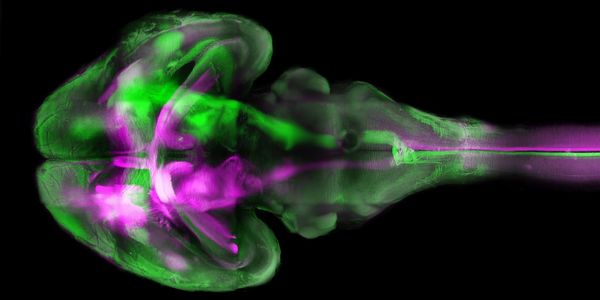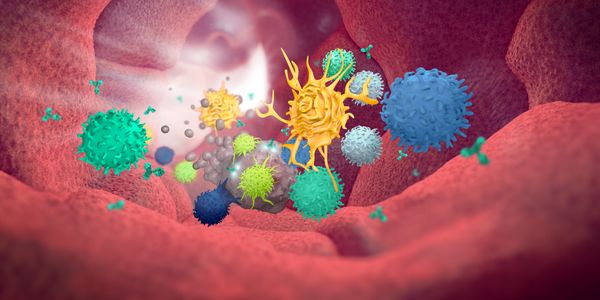Animal Models
Animal Models a living organisms in which normative biology or behavior can be studied, or in which a spontaneous or induced pathological process can be investigated, and in which the phenomenon in one or more respects resembles the same phenomenon in humans or other species of animal.
-
APR 20, 2021 | 12:00 AMC.E. CREDITSMicrobial communities include distinct lineages of closely related organisms which have proved challenging to separate in metagenomic assembly. Challenges include the existence of highly rel...APR 20, 2021 | 12:00 AMMany diseases show sex differences in incidence or progression, suggesting that one sex has inherent biological factors that protect from or exacerbate disease. Historically the root causes...APR 20, 2021 | 12:00 AMIn mammals, DNA methylation is an epigenetic mark that regulates gene expression by serving as a maintainable mark whose absence marks promoters and enhancers. Recent epidemiological studies...APR 07, 2021 | 12:00 AMCell encapsulation within semi-permeable devices represents a local immunoisolation strategy for cell-based therapies without the need for systemic immunosuppression. The encapsulation syste...MAR 11, 2021 | 8:00 AMDate: March 11, 2021 Time: 8:00am (PST), 11:00am (EST) g the toxicity profile of a compound is a necessity across industries and the various stages of drug development. Early stage mechanism...FEB 10, 2021 | 12:00 AMPain management includes the choice of analgesia agents, their dose, administration method, duration and frequency of treatment, and a pain-monitoring scheme for each individual animal. Insu...FEB 10, 2021 | 12:00 AMLearning Objectives: 1. Methods on how to aseptically use foil (Reynolds Wrap) in rodent surgery 2. Methods on how aseptically use cling film (Press N' Seal) in rodent surgery 3. Long-te...Speaker: Raphael A. Malbrue, DVM, MS, CertAqVPresented at: Laboratory Animal Sciences Virtual Event Series 2021
FEB 10, 2021 | 12:00 AMThere is growing concern about the reliability of biomedical research results. Poor experimental design, inappropriate analysis methods and incomplete reporting have all contributed to incon...FEB 03, 2021 | 8:00 AMDate: February 3, 2021 Time: 8:00am (PST), 11:00am (EST) This introduction webinar will provide you with an overview of the general immuno-oncology (IO) research field...DEC 03, 2020 | 4:30 PMThis drug development program is designed to create a family of broad-spectrum, pan-coronaviral drugs that respectively inhibit multiple key enzymes required for viral replication. By target...DEC 03, 2020 | 10:00 AMCases and deaths continue to increase steadily in most states. The pace of increase is faster than we expected, leading us to revise upward IHME forecast of deaths and cases into the future....DEC 03, 2020 | 9:00 AMDynamic models of infectious disease systems are often used to study the epidemiological characteristics of disease outbreaks, the ecological mechanisms and environmental conditions affectin...DEC 03, 2020 | 12:00 AMAntibody tests are important tools to assess the efficacy of vaccine candidates and to derive suitable vaccination modalities. High specificity and sensitivity are of great importance for th...DEC 03, 2020 | 12:00 AMSARS-CoV-2 had spread with speed unknown in recent history across the globe, sickening >50M people and killing over 1M. By far the most of the severe cases and deaths were registered amon...NOV 18, 2020 | 8:00 AMDATE: November 18, 2020 TIME: 08:00am PDT We develop and implement technologies to solve some of the major bottlenecks in biomedical research. In particular, we establish new imaging approac...November 13, 2020 4:00 PM PST | November 14, 2020 8:00 AM SGTThree-dimensional (3D) cell culture spheroids and aggregates are preferred over monolayer cell culture due to their architectural and functional similarity to solid tumors. To study expressi...November 12, 2020 9:00 AM PST | 4:00 PM GMTThree-dimensional (3D) cell culture spheroids and aggregates are preferred over monolayer cell culture due to their architectural and functional similarity to solid tumors. To study expressi...NOV 12, 2020 | 12:00 AMImmunohistochemistry (IHC) is used to determine spatial relationships where we can identify the localization of target proteins in specific regions and cells of a tissue. IHC has been the go...OCT 20, 2020 | 9:00 AMDATE: October 20th, 2020 TIME: 08:00am PT, 11:00am ET Tumor-associated macrophages (TAMs) are key cells in the tumor microenvironment (TME) with diverse immune functions that have a major in...OCT 08, 2020 | 10:30 AMImmunohistochemistry (IHC) is used to determine spatial relationships where we can identify the localization of target proteins in specific regions and cells of a tissue. IHC has been the go...Speaker: Vivian Barry, MSPresented at: Cancer Research & Oncology Week Virtual Event Series 2020
Sponsored By: Roche DiagnosticsOCT 01, 2020 | 10:00 AMDate: October 10, 2020 Time: 10:00am (PDT), 1:00pm (EDT) Rodent bile collection studies can be challenging. Not only do they require a technically difficult surgery, but there is also a lear...SEP 30, 2020 | 12:00 PMThe CRISPR/Cas genome editing system has revolutionized nearly every aspect of the life science industry. Until recently, the most used formats for this technology have been plasmids, mRNA,...Speaker: Gurpreet Balrey, PhD , Peter Romanienko, PhDSEP 30, 2020 | 7:30 AMGenome Engineering allows the easy manipulation of genomes down to the nucleotide level. Targeted deep sequencing enables the detection and quantification of low-frequency editing events. Ho...SEP 30, 2020 | 6:00 AMGenome editing with an expanded CRISPR-Cas tool set increases the opportunity to make intentional, targeted changes in the genome. Furthermore, improved specificity of genome editing and abi...
APR 20, 2021 | 12:00 AM
C.E. CREDITS
Microbial communities include distinct lineages of closely related organisms which have proved challenging to separate in metagenomic assembly. Challenges include the existence of highly rel...
APR 20, 2021 | 12:00 AM
Many diseases show sex differences in incidence or progression, suggesting that one sex has inherent biological factors that protect from or exacerbate disease. Historically the root causes...
APR 20, 2021 | 12:00 AM
In mammals, DNA methylation is an epigenetic mark that regulates gene expression by serving as a maintainable mark whose absence marks promoters and enhancers. Recent epidemiological studies...
APR 07, 2021 | 12:00 AM
Cell encapsulation within semi-permeable devices represents a local immunoisolation strategy for cell-based therapies without the need for systemic immunosuppression. The encapsulation syste...
MAR 11, 2021 | 8:00 AM
Date: March 11, 2021 Time: 8:00am (PST), 11:00am (EST) g the toxicity profile of a compound is a necessity across industries and the various stages of drug development. Early stage mechanism...
FEB 10, 2021 | 12:00 AM
Pain management includes the choice of analgesia agents, their dose, administration method, duration and frequency of treatment, and a pain-monitoring scheme for each individual animal. Insu...
FEB 10, 2021 | 12:00 AM
Learning Objectives: 1. Methods on how to aseptically use foil (Reynolds Wrap) in rodent surgery 2. Methods on how aseptically use cling film (Press N' Seal) in rodent surgery 3. Long-te...
Speaker:
Raphael A. Malbrue, DVM, MS, CertAqV
Presented at: Laboratory Animal Sciences Virtual Event Series 2021
FEB 10, 2021 | 12:00 AM
There is growing concern about the reliability of biomedical research results. Poor experimental design, inappropriate analysis methods and incomplete reporting have all contributed to incon...
FEB 03, 2021 | 8:00 AM
Date: February 3, 2021 Time: 8:00am (PST), 11:00am (EST) This introduction webinar will provide you with an overview of the general immuno-oncology (IO) research field...
DEC 03, 2020 | 4:30 PM
This drug development program is designed to create a family of broad-spectrum, pan-coronaviral drugs that respectively inhibit multiple key enzymes required for viral replication. By target...
DEC 03, 2020 | 10:00 AM
Cases and deaths continue to increase steadily in most states. The pace of increase is faster than we expected, leading us to revise upward IHME forecast of deaths and cases into the future....
DEC 03, 2020 | 9:00 AM
Dynamic models of infectious disease systems are often used to study the epidemiological characteristics of disease outbreaks, the ecological mechanisms and environmental conditions affectin...
DEC 03, 2020 | 12:00 AM
Antibody tests are important tools to assess the efficacy of vaccine candidates and to derive suitable vaccination modalities. High specificity and sensitivity are of great importance for th...
DEC 03, 2020 | 12:00 AM
SARS-CoV-2 had spread with speed unknown in recent history across the globe, sickening >50M people and killing over 1M. By far the most of the severe cases and deaths were registered amon...
NOV 18, 2020 | 8:00 AM
DATE: November 18, 2020 TIME: 08:00am PDT We develop and implement technologies to solve some of the major bottlenecks in biomedical research. In particular, we establish new imaging approac...
November 13, 2020 4:00 PM PST | November 14, 2020 8:00 AM SGT
Three-dimensional (3D) cell culture spheroids and aggregates are preferred over monolayer cell culture due to their architectural and functional similarity to solid tumors. To study expressi...
November 12, 2020 9:00 AM PST | 4:00 PM GMT
Three-dimensional (3D) cell culture spheroids and aggregates are preferred over monolayer cell culture due to their architectural and functional similarity to solid tumors. To study expressi...
NOV 12, 2020 | 12:00 AM
Immunohistochemistry (IHC) is used to determine spatial relationships where we can identify the localization of target proteins in specific regions and cells of a tissue. IHC has been the go...
OCT 20, 2020 | 9:00 AM
DATE: October 20th, 2020 TIME: 08:00am PT, 11:00am ET Tumor-associated macrophages (TAMs) are key cells in the tumor microenvironment (TME) with diverse immune functions that have a major in...
OCT 08, 2020 | 10:30 AM
Immunohistochemistry (IHC) is used to determine spatial relationships where we can identify the localization of target proteins in specific regions and cells of a tissue. IHC has been the go...
Speaker:
Vivian Barry, MS
Presented at: Cancer Research & Oncology Week Virtual Event Series 2020
Sponsored By: Roche Diagnostics
Sponsored By: Roche Diagnostics
OCT 01, 2020 | 10:00 AM
Date: October 10, 2020 Time: 10:00am (PDT), 1:00pm (EDT) Rodent bile collection studies can be challenging. Not only do they require a technically difficult surgery, but there is also a lear...
SEP 30, 2020 | 12:00 PM
The CRISPR/Cas genome editing system has revolutionized nearly every aspect of the life science industry. Until recently, the most used formats for this technology have been plasmids, mRNA,...
Speaker:
Gurpreet Balrey, PhD
, Peter Romanienko, PhD
SEP 30, 2020 | 7:30 AM
Genome Engineering allows the easy manipulation of genomes down to the nucleotide level. Targeted deep sequencing enables the detection and quantification of low-frequency editing events. Ho...
SEP 30, 2020 | 6:00 AM
Genome editing with an expanded CRISPR-Cas tool set increases the opportunity to make intentional, targeted changes in the genome. Furthermore, improved specificity of genome editing and abi...






















